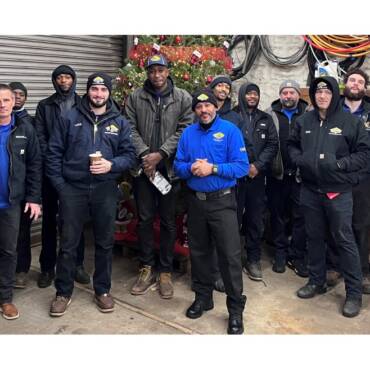A common component used on walk-in coolers, freezers, and other refrigeration equipment is the liquid line solenoid. It is a fluid control device that is used to stop the flow of refrigerant to an evaporator during the off cycle. It consists of a magnetic coil and a valve body that has a plunger used to either stop or allow the flow of refrigerant through its body. It is a normally closed valve, designed to stop the flow of refrigerant when its coil is de-energized and allow full refrigerant flow when energized.
On systems with a single evaporator and condensing unit, the main function of a liquid line solenoid is to “pump out” the refrigerant in the evaporator during the off cycle. This will prevent refrigerant from migrating back to the compressor any time the compressor is exposed to a colder ambient temperature than the evaporator, which is possible during the winter months on systems with an air-cooled condensing unit located outdoors.
When the temperature control reaches its cut-out setting, the circuit will de-energize the coil of the liquid line solenoid. This will stop the flow of refrigerant to the metering device and into the evaporator. With the compressor still running, the refrigerant will be pumped out of the evaporator. When the low-side pressure gets to a value that ensures the refrigerant is sufficiently pumped out of the evaporator, a low-pressure switch will cycle the compressor off.
Installation Information
Liquid line solenoids can also be used on systems with multiple evaporators installed in different cases. This will allow for individual temperature control in each case.
Most solenoid valves can be mounted horizontally, on their side, or in a vertical line; however, this might not be possible with all solenoid valves. Always check the manufacturer’s installation instructions to verify any limitations on the valve’s orientation. Many valves are also directional, meaning the refrigerant is designed to flow in one direction only. If the valve were piped in backward, it would not properly close when its coil is de-energized. Most valves will have an arrow, or the word “IN,” stamped on the body to indicate the correct piping orientation.
Avoid overheating the valve body when applying heat during the brazing process, and always remove the coil from the valve body. Overheating the valve body can damage it, so use a heat paste or wet rag to protect it. Also, the tip of the torch should be large enough to avoid prolonged heating, and the flame should be directed away from the valve body. Always read the manufacturer’s instructions before applying heat to a valve, as some valves may require disassembly before applying any heat.
Solenoid Failure
A liquid line solenoid can fail in one of three ways: the coil burns out, the valve fails to mechanically open, or the valve fails to mechanically close. If the valve should be open and you suspect it is not, first check to see if its coil is magnetized. This can be done effectively in one of two ways. You can take a small screwdriver and touch the top of the coil, and you should feel a magnetic pull on the screwdriver. Another method is to take the jaws of a clamp-on ammeter and with the jaws open, place the open end next to the coil — you should see an amperage value on the meter. The meter will pick up the magnetic field generated by the coil if it is energized. If either of these tests fails, check if the correct voltage is applied to the coil. If no voltage or the incorrect voltage is measured, the issue is the control circuit and not the valve. If the correct voltage is applied, the coil is defective and needs to be replaced.
If you find it necessary to remove the coil from the valve body to check the coil, never energize the coil with no load on it. An energized coil with no load will quickly overheat and burn out. If you need to check the coil energized with it removed from the valve body, you can place a screwdriver or metal rod in the center of the coil that will act as a load and prevent the coil from overheating while testing. If you find the coil is energized and the valve still fails to open, it is likely a mechanical issue within the valve, and the valve body will need to be replaced. If you can, try cycling the voltage to the coil a few times to see if you can get the valve open, but even if you can, it is best to change out the valve as it is likely to fail again.
A valve that fails to properly close will not properly stop the flow of refrigerant into the evaporator. On single evaporator systems using the liquid line solenoid as a pump down valve, the compressor will either continue to run or will continuously short cycle. The low-side pressure may initially drop low enough to cycle on the low-pressure switch, but as the refrigerant bleeds through the valve. it will raise the suction pressure above the low-pressure switch’s cut-in and cycle the compressor back on.
When replacing a liquid line solenoid always make sure the coil is a match for the valve body. Some valves are sold separately, so it is possible to pick up an unmatched set, or if just replacing the valve body or coil, it is possible to pick up the wrong component.
Troubleshooting and replacing a liquid line solenoid is generally not a difficult task. Knowing the basics of their design and operation will be an asset to any technician during a repair.
Whether you require installation, repair, or maintenance, our technicians will assist you with top-quality service at any time of the day or night. Take comfort in knowing your indoor air quality is the best it can be with MOE heating & cooling services Ontario's solution for heating, air conditioning, and ventilation that’s cooler than the rest.
Contact us to schedule a visit. Our qualified team of technicians, are always ready to help you and guide you for heating and cooling issues. Weather you want to replace an old furnace or install a brand new air conditioner, we are here to help you. Our main office is at Kitchener but we can service most of Ontario's cities
Source link


